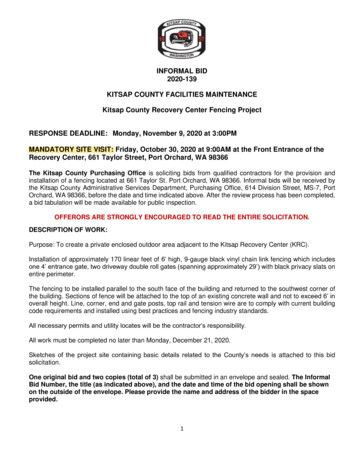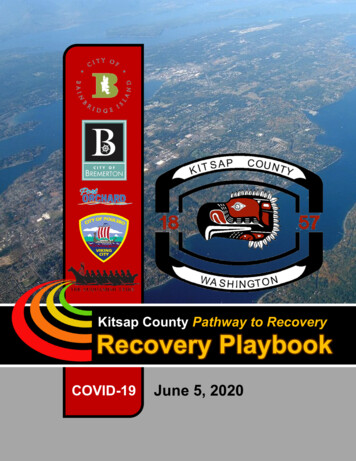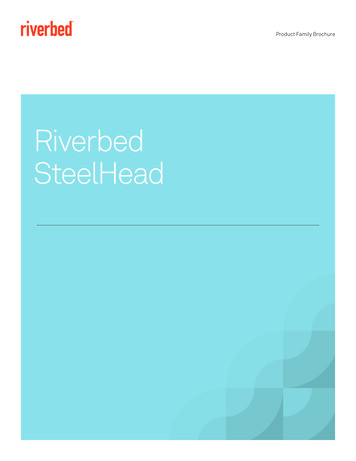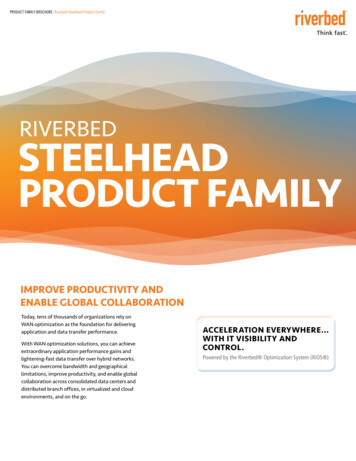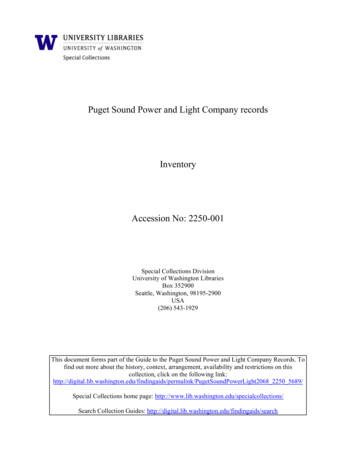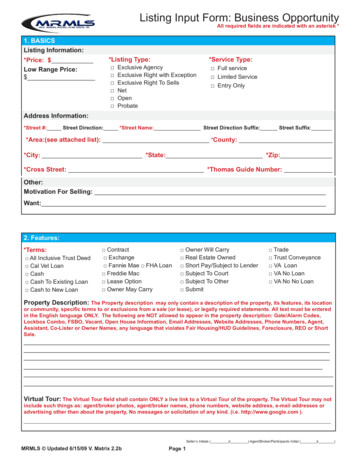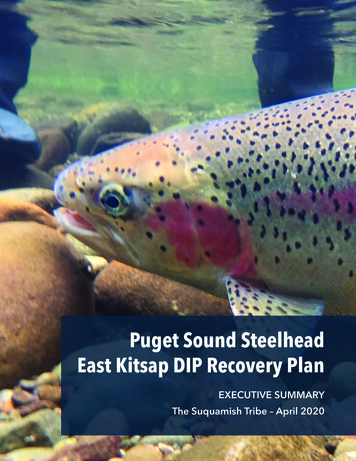
Transcription
Executive Summary The Suquamish Tribe – April 2020Puget Sound SteelheadEast Kitsap DIP Recovery PlanEXECUTIVE SUMMARYThe Suquamish Tribe – April 2020Puget Sound Steelhead East Kitsap DIP Recovery Plan1
Executive Summary The Suquamish Tribe – April 2020Table of ContentsBackground 3Vision 5Steelhead: What Makes Them Unique?6East Kitsap Geography 7Recovery Goals 14Strategies for Recovery 17Implementation 19Adapting Over Time 212Puget Sound Steelhead East Kitsap DIP Recovery Plan
Executive Summary The Suquamish Tribe – April 2020BackgroundThe National Marine Fisheries Service (NMFS) listed Puget Sound steelhead as a threatened species under theEndangered Species Act in 2007. In December 2019, NOAA released the final version of the Endangered SpeciesAct Recovery Plan for Puget Sound Steelhead (Regional Plan). Thirty-two populations of Puget Sound steelhead aregrouped into three major population groups (MPGs): Northern Cascades MPG, Central and South Puget SoundMPG, and Hood Canal and Strait of Juan de Fuca MPG. The East Kitsap Demographically Independent Population(DIP) is a part of the Central and South Puget Sound MPG and the focus of this recovery plan. The East Kitsap DIP isfurther divided into seven subwatersheds.Puget Sound Steelhead East Kitsap DIP Recovery Plan3
Executive Summary The Suquamish Tribe – April 2020I s l a n dC l a l l a mS n o h o m i s hBigValley-FrontalPuget SoundPugetSoundJ e f f e r s o nBainbridgeIslandChico CreekFrontalSinclair InletSEATTLEK i t s a pHoodCaPath: U:\GIS\GIS\Projects\18xxxx\D180323.00 Suquamish Tribe Steelhead Recovery Plan\03 MXDs Projects\SWIFD Data.mxd, mmccart 4/28/2020nalElliottBayWRIA 15BlackjackCreek-FrontalPort OrchardCurleyCreek-FrontalColvos PassageVashonIslandK i n gM a s o nCarrInletTACOMAEast Kitsap DIPBoundaryLead Entity BoundaryP i e r c eT h u r s t o n0NSubwatershedBoundary10MilesSOURCE: DigitalGlobe, 2016; ESA, 2018; WA Ecology, 2016; WA DNR,2018EastKitsapWRIA BoundaryDIPD180323.Suquamish Tribe Steelhead Recovery PlanFigure 2Winter Steelhead Distribution4Puget Sound Steelhead East Kitsap DIP Recovery Plan
Executive Summary The Suquamish Tribe – April 2020VisionWe envision steelhead recovery in East Kitsap that results in: abundant, productive, diverse, and resilient steelheadand salmon populations that support ecosystem processes; an East Kitsap steelhead population that contributesto the viability of Puget Sound steelhead and that supports recreational, ceremonial, and subsistence harvest; anEast Kitsap ecosystem that supports the full exercise of tribal treaty harvesting rights; the best and most productivestream systems and habitats being accessible, functioning, and in long term protective status; and significantprogress in restoring impacted stream systems.Puget Sound Steelhead East Kitsap DIP Recovery Plan5
Executive Summary The Suquamish Tribe – April 2020Steelhead:What Makes Them Unique?Puget Sound steelhead (Oncorhynchus mykiss) exhibit one of the most complex life cycles of all the salmonid species.This species may be anadromous, moving between salt water and freshwater throughout their life, or remain exclusivelyin freshwater (referred to as rainbow trout). Puget Sound steelhead typically spend one to three years rearing infreshwater, with most spending two years in streams and rivers before migrating to the ocean (Busby et al., 1996).Because of the biological differences betweensteelhead and other threatened Pacific salmon speciesin Puget Sound, the management of steelheaddemands a unique approach. Unlike chum and Chinook, and more similar to coho,steelhead spend more time in streams before theymigrate to Puget Sound, making them susceptibleto water quality and quantity stressors, including lowflows and warm temperatures in summer. The streams that steelhead use are often smallerthan those used by Chinook salmon. Steelhead can extend further upstream inwatersheds than chinook or chum.After spawning, some female steelhead survive andcan return to spawn again (kelts). These individualsare believed to dramatically boost the productivityof the population. Steelhead smolts are larger than those of othersalmon species and they may be prone to higherrates of predation once they reach Puget Sound.Oncorhynchus mykiss Life Cycle6Puget Sound Steelhead East Kitsap DIP Recovery Plan
Executive Summary The Suquamish Tribe – April 2020East KitsapGeographyThe East Kitsap DIP is comprised of 7 subwatersheds.Streams within each subwatershed were grouped intothree tiers based on the extent of historically availablesteelhead habitat. Tiering priorities should be used inthe development of future projects and as guidancerather than a strict requirement. Projects in lower tiersare still important to consider when consistent with therecovery strategies and where there is a demonstratedneed.Puget Sound Steelhead East Kitsap DIP Recovery Plan7
Executive Summary The Suquamish Tribe – April 2020Executive Summary The Suquamish Tribe – April 2020East Kitsap DIPSubwatersheds andDrainagesNon-Tiered/Non-SteelDrainagesTier 1 DrainageTier 2 DrainageTier 3 DrainageSubwatersheds (HUC 12Boundary)WRIA Boundary02MilesDoCrBliss CrThompson Cr/Kleabel CrEast Kitsap: North8Big Va lley-FrontalPugetSoundDoe Kag WatsEstuary CrCowling CrLemolo CrBig Scandia Crgf is hCarpenter CrGrovers CrK i t s a pPuget Sound Steelhead East Kitsap DIP Recovery PlanNPugetSound
over s CrCarpenter CrGrExecutive Summary The Suquamish Tribe – April 2020Executive Summary The Suquamish Tribe – April 2020East Kitsap DIPSubwatersheds gE stuEstuar Watsary Cry CrTier 1 DrainageTier 2 DrainageTier 3 DrainageDo e KagSubwatersheds (HUC 12Boundary)WRIA Boundary02CrerryrkBaSteele CrStra wbCe r Crle a r CrMilesDyesInletcoChiBarkerCreek-FrontalDyes InletNSpringbrook/Fletcher r InletCrSinclairInletPugetSoundlmonberryCrK i t s a pSaVashon IslandEast Kitsap: CentralPuget Sound Steelhead East Kitsap DIP Recovery Plan9
Executive Summary The Suquamish Tribe – April 2020East Kitsap DIPSubwatersheds andDrainagesNon-Tiered/Non-SteelDrainagesTier 1 DrainageTier 2 DrainageTier 3 DrainageSinclairInletn berry CrWRIA Boundary02almoMilesSC u r leKarcherCrAnnapoli /s Crrc kj a c k Cy/CurleyCreek-FrontalColvos PassageB laBailt ort OrchardSubwatersheds (HUC 12Boundary)OlallaCrNorth ForkOlalla CrVashonIslandK i t s a pCrescent CrCr rrt h y CNo n k eo/DEast Kitsap: South10Puget Sound Steelhead East Kitsap DIP Recovery PlandC rJudChristiansen CrN
Executive Summary The Suquamish Tribe – April 2020A pressure assessment was conducted to evaluate hownumerous impacts from human activities affect thedifferent steelhead life history stages in the East Kitsapsteelhead population.The pressure assessment rates the scope, severity,and permanence of each pressure as it relates to thevarious steelhead life history stages: adult spawning,egg incubation and emergence, juvenile rearing,smolts/early marine, maturation/open ocean, and adultmigration, holding, and kelts.Pressures and Stressors in East KitsapPuget Sound Steelhead East Kitsap DIP Recovery Plan11
Executive Summary The Suquamish Tribe – April 2020Pressure Summary RatingScope:The geographic orspatial extent of thepressure in the EastKitsap DIP.Severity:The level of damageexpected within :The degree towhich the effectsof the pressure canbe reversed withintervention.12Puget Sound Steelhead East Kitsap DIP Recovery Plan
Executive Summary The Suquamish Tribe – April 2020Climate Change and SteelheadAdditional climate impacts on steelhead outside offreshwater include:Climate change is a multi-faceted pressure facingsteelhead. This plan addresses climate change byconsidering impacts that will likely change the structure,extent, or function of habitat or directly affect steelheadsurvival.The climate impacts to freshwater ecosystems thatdirectly affect the quantity and quality of steelheadhabitat include: Increased high flows associated with increasedstorms Decreased low flows in summer Higher water temperatures Warming surface temperatures in the Pacific Changes in the marine foodweb, includingincreased predation Coastal squeeze impacting forage fish habitat Ocean acidificationThe overarching approach for addressing climatechange for the East Kitsap DIP is to identify andimplement additional strategies and actions that adaptto climate change and address the pressures andstressors exacerbated by climate change, such as wateravailability, habitat connectivity and water quality.Puget Sound Steelhead East Kitsap DIP Recovery Plan13
Executive Summary The Suquamish Tribe – April 2020Recovery GoalsIf the strategies and actions identified in this plan areput into place, steelhead recovery goals are expectedto be achieved.Setting steelhead goals helps communicate aquantifiable and achievable population size that alignswith the vision set out for recovery. The Suquamish Tribeand partners based the population goals on historicextent of steelhead in the East Kitsap geography andused estimates of steelhead production from nearbystreams. The abundance goal is expressed as a range(841-3,000). If the population is less productive, morespawners are needed to meet the recovery goal.If fewer fish are producing more offspring (higherproductivity), then a lower number of spawnerscan achieve the recovery goal. Achieving the goalsidentified in the East Kitsap DIP Steelhead Recoveryplan will lead to improved spatial structure and geneticdiversity for Puget Sound steelhead overall and leadto delisting. Additional information will allow forsetting and refining goals as more is known about thispopulation.14East Kitsap DIP population goalsProductivity scenarios:Abundance goals:Puget Sound Steelhead East Kitsap DIP Recovery PlanLow 1 Recruit/SpawnerHigh 2.62Recruit/Spawner3,000841
Executive Summary The Suquamish Tribe – April 2020This plan also sets long-term habitat goals for East Kitsap by identifying the most important habitat types forsteelhead:Upland Forest CoverBy 2070, forest cover extent is increased to or exceeds 65% in all seven subwatersheds.Specific goals:Unit: Sub-watershedDesired Outcome(increase or maintain)2070 GoalCurrent StatusBig Valley–Dogfish current levels69% 21,621 acresBarker-Dyes65%43% 8,402 acresBlackjack65%61% 12,369 acresCurley–Colvos current levels68% 18,123 acresChico-Sinclair current levels75% 9,348 acresBainbridge Island current levels70% 7,022 acresVashon Island current levels73%Freshwater WetlandsBy 2070, freshwater wetland extent has increased beyond the current status in all seven subwatersheds.Specific goals:Unit: Sub-watershed2070 GoalCurrent StatusBig Valley–Dogfish current levels4.7% 1,477 acresBarker-Dyes current levels3.9% 745 acresBlackjack current levels4.2% 925 acresCurley–Colvos current levels5.2% 1,373 acresChico-Sinclair current levels5.7% 703 acresBainbridge Island current levels3.7% 372 acresN/AN/AVashon IslandDesired Outcome(increase or maintain)N/APuget Sound Steelhead East Kitsap DIP Recovery Plan15
Executive Summary The Suquamish Tribe – April 2020Riparian AreasBy 2070, riparian cover in all steelhead streams has increasedSpecific goals:Unit: Sub-watershedDesired Outcome(increase or maintain)2070 GoalCurrent StatusBlackjack Creek current levels39% coverChico Creek current levels56% coverClear Creek current levels29% coverCurley Creek current levels40% coverGorst Creek current levels69% coverGrovers Creek current levels35% coverStream Channel: AccessibilityBy 2030, steelhead can access 100% of historically accessible habitat in all six of the Tier 1 drainages (Blackjack,Chico, Curley, Clear, Gorst, Grovers).By 2070, steelhead can access 100% of historically accessible habitat throughout the East Kitsap DIP geography.Stream Channel: Floodplain FunctionBy 2070, increase connectivity and floodplain function in all primary steelhead drainages.Water availabilityBy 2070, instream flows are sufficient and cool enough during summer low flow periods for all steelhead life stagesto thrive in East Kitsap streams.Marine foodwebBy 2070, forage fish have increased access to spawning and rearing habitat in East Kitsap and have robustpopulations throughout Puget Sound in balance with pinniped populations, so that sufficient numbers of steelheadsmolts survive the migration through Puget Sound.16Puget Sound Steelhead East Kitsap DIP Recovery Plan
Executive Summary The Suquamish Tribe – April 2020Strategies forRecoveryOver time, steelhead abundance and productivitywill increase if stakeholders implement strategiesthat remove the pressures and reduce the stressorsthat impact steelhead habitat and populations in EastKistap. Eventually, these collective actions, includingcapital projects and policy improvements, will lead torecovery of the population.Puget Sound Steelhead East Kitsap DIP Recovery Plan17
Executive Summary The Suquamish Tribe – April 2020The graphic below demonstrates how strategies lead to recovery of steelhead and habitat.Act to reduce, removeor ameliorate humanimpacts (pressures).Strategies.which reducesstressors.PressuresProjects andactions.ultimatelyimproving habitatconditions.StressorsHabitat.and a steelheadresponse.SteelheadStrategies to RecoveryThe Suquamish Tribe identified five principles to guide strategy development:12345Protect the best(most intact) habitatManage forhydrologic maturityin forestlandsRestore accessand connectivity tofreshwater habitatsthrough fish passageand floodplainreconnectionProtect and restorehabitat on largeparcels at riskof conversionto residentialor commercialdevelopmentEnsure adequateamounts of water instreams critical tosteelhead freshwaterlife historiesThe strategies identified in the plan to reach recoveryof steelhead were developed using those identifiedin the Puget Sound Steelhead Recovery Plan, andlocal watershed assessments and salmon recovery18plans. The thirteen strategies articulated as necessaryto reach recovery encompass freshwater protectionand regulations, freshwater habitat restoration, marineimprovements, and fisheries management.Puget Sound Steelhead East Kitsap DIP Recovery Plan
Executive Summary The Suquamish Tribe – April 2020ImplementationThe strategies identified in this plan are intended tobe implemented through projects and actions by avariety of stakeholders in East Kitsap, from electedofficials to landowners.Puget Sound Steelhead East Kitsap DIP Recovery Plan19
Executive Summary The Suquamish Tribe – April 2020Certain organizations and stakeholders in East Kitsap will be particularly well suited to execute the strategiesidentified in the plan. The table below provides examples as to which entity could best implement each strategyStrategyResponsible EntitiesAcquire and conserve priority steelheadhabitatCounties, cities, Tribes, land trusts, WDNR, WDFWEnforce and improve land use regulationsCounties, cities, Tribes, non-profit partnersProtect water availability and water qualityCounties, cities, utilities, Tribes, non-profit partners, WDOE, EPA, NavyRemove barriers to fish passage andlongitudinal connectivityCounties, cities, private landowners, non-profit partners, WDFW,WSDOT, NavyImprove lateral habitat connectivity in thefloodplainProject sponsors (Counties, cities, Tribes, non-profit partners, WDFW)Increase channel complexityProject sponsors (Counties, cities, Tribes, non-profit partners, WDFW)Restore and improve functional ripariancorridorsCounties, cities, Tribes, private landowners, project sponsorsIncrease hydrologic function and improvewater qualityCounties, cities, Tribes, private landowners, non-profit partners,WDFW, WDOE, EPAProtect and restore forage fish spawningand rearing habitatCounties, cities, Tribes, non-profit partners, WDFW, NavyAddress artificial haul-out sites ofpinnipedsNMFS, Tribes, WDFW, PSP, NavyReduce predation in freshwater lakesWDFW, TribesPrevent illegal/incidental harvestWDFW, TribesExplore possible native hatchery programNMFS, Tribes, WDFWIn this plan, Appendix C outlines a collection of specificrecovery projects and action opportunities throughoutthe East Kitsap DIP referred to as the Ten-year Start List.These projects and actions are sourced from watershedrestoration plans recently completed for watersheds inEast Kitsap and have been thoroughly vetted by localstakeholders. These projects and actions are groupedinto categories:20 Fish passage Floodplain restoration Riparian plantings Increased channel complexity Land use and zoning Acquisitions NearshoreThe actions and projects identified in the Ten-year StartList represent a starting point toward steelhead recoveryin the East Kitsap DIP. Each project and action identifiedincludes the project name, identification number,description, and projected outcome.Puget Sound Steelhead East Kitsap DIP Recovery Plan
Executive Summary The Suquamish Tribe – April 2020AdaptingOver TimeThis recovery plan was developed using an adaptivemanagement framework with the understanding that asmore research is conducted on East Kitsap and PugetSound steelhead, gaps in information will be filled withnew knowledge to advance the implementation ofstrategies in the plan.Puget Sound Steelhead East Kitsap DIP Recovery Plan21
Executive Summary The Suquamish Tribe – April 2020In general, adaptive management consists of five parts.1Set a vision andidentify goals5Capturelessons learnedand sharethe results4Analyzedata and use theresults to adaptassumptions andapproachThe goals, strategies, and actions within the EastKitsap Steelhead Recovery Plan will benefit from newmonitoring and research efforts.Currently, there is little information or data that existsregarding steelhead biology or habitat use in EastKitsap. Collecting and incorporating new data andinformation about steelhead in the East Kitsap DIP isan important component of the adaptive managementframework presented in this plan.With new knowledge, new projects can be added to theImplementation Schedule, strategies can be revised,and goals can be made more specific with quantifiabletargets. An annual steelhead roundtable where newinformation on steelhead data and projects are sharedand discussed will assist with the adaptive managementprocess. Additionally, leveraging the collaborationbetween stakeholders through the West Sound Partnersfor Ecosystem Recovery (WSPER) will be an importantcomponent in the adaptive management process.22Puget Sound Steelhead East Kitsap DIP Recovery Plan2Plan actionsand identifymonitoringneeds3Implementand monitor
Executive Summary The Suquamish Tribe – April 2020The Suquamish Tribe would like to acknowledge the following organizationsfor providing their support and expertise to inform the development of thisrecovery plan:Suquamish TribeKitsap CountyPierce CountyKing CountyCity of Port OrchardCity of Bainbridge IslandCity of BremertonCity of Gig HarborCity of PoulsboWild Fish ConservancyMid-Sound Fisheries Enhancement GroupSouth Puget Sound Salmon Enhancement GroupStillwaters Environmental CenterBainbridge Island Land TrustKey Pen ParksNational Oceanic & Atmospheric AdministrationPuget Sound PartnershipWashington Department of Fish & WildlifeWashington State Recreation & Conservation OfficeSalish Sea Marine Survival Project Steelhead Technical CommitteeNorthwest Indian Fisheries CommissionWest Sound Partners in Ecosystem RecoveryFor more information regarding this recovery plan, please contact:Steve Todd, Salmon Recovery Biologist, stodd@suquamish.nsn.usPuget Sound Steelhead East Kitsap DIP Recovery Plan23
Puget Sound Steelhead East Kitsap DIP Recovery Plan. Executive Summary The Suquamish Tribe - April 2020. East Kitsap: South. Sinclair Inlet. Christiansen Cr. r r. North Fork Olalla Cr. Kitsap. Vashon Island Curley Creek-Frontal Colvos Passage Blackjack Creek-Frontal Port Orchard. O l l l a C r G o r s t C r C e s c e n t C r r
